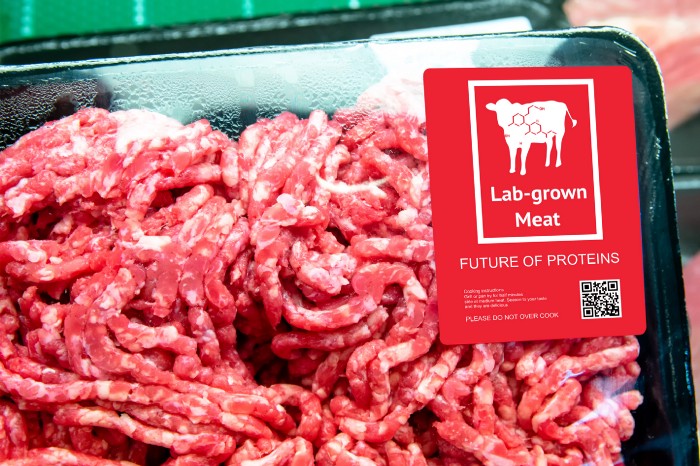In October 2018, the CEO of alternative protein company JUST, Josh Tetrick, wrote a message to American Agriculture Secretary Sonny Perdue. But, it didn’t talk about the overwhelming amount of rules and regulations that was preventing his cellular agriculture company from bringing products to market. Rather, it talked about the underwhelming amount of rules and regulations that was doing just this.
For anyone who has ever had to contend with any sort of bureaucracy, Tetrick’s problem, and the problem of basically every cultured meat producer around the world, may not sound like much. Instead of there being too many forms to fill out, inspections to endure, stamps to obtain and requirements to satisfy, there are simply none.
But because there is no defined way of handling cellular agriculture products (both in the United States and elsewhere), it means that many companies working in this space can’t start selling their products to consumers, at least not securely.
Particularly with cultured meat — which the average shopper is probably at least slightly uncomfortable with — a lack of government oversight and endorsement would deter consumers even more from wanting to try these kinds of products.
With out any sort of regulatory system, companies who do attempt to sell their products would probably open themselves up to countless lawsuits and the odd, unprepared company could make some kind of technical or marketing mistake that irreparably damages the reputation of cultured meat.
So, basically a lack of regulations might actually be worse.
“Companies pursuing innovative, sustainable meat technology,” Tetrick wrote, “need clarity about regulatory expectations and a defined path to market.”
Luckily for Tetrick and other American cultured meat producers, in November 2018, the FDA and USDA announced a joint partnership in regulating the production and sales of cultured meat. In March 2019, they came up with a memorandum of understanding which specified who exactly, will do what parts.
Overall, their report determined that the FDA will oversee “cell collection, cell banks, and cell proliferation and differentiation, including inspections of cell banks and culturing facilities to ensure compliance with FDA regulations” while the USDA will “inspect harvesting and post-harvesting facilities, approve cultivated meat labels, and verify the applicability of these labels through inspections”.

How was this decided?
After it was established that some kind of regulatory process was needed, the first issue was figuring out who was going to be in charge of said process.
The FDA who was, up until now, in charge of everything related to cell cultures was assumed to be the obvious choice. But, potentially unnerved by this new competition in the meat market, the National Cattlemen’s Beef Association (NCBA) insisted upon having representation. As such, they pushed for the USDA — an organization which they have quite a bit of say in — to be part of the process.
Now, the FDA’s authority is justified by the Federal Food, Drug and Cosmetic Act which gives them the responsibility to ensure that foods are safe, wholesome, sanitary, properly labelled and that human/veterinary drugs are safe and effective.
Under this Act, the FDA is required to intervene in the cases of “adulterated foods” which are foods that don’t meet the current legal standards — in this case cell based products because, well, there are no standards.
The USDA’s authority comes from the Federal Meat Inspection Act and the Poultry Meat Inspection Act which gives them the responsibility to make sure that meat and poultry to are produced in sanitary conditions, are safe, unadulterated, and accurately labeled. It also means that they have to make sure that any imported meat achieves a U.S. safety standard.
Following a “public comment” period in which any citizen is allowed to send in a concern/comment which the FDA and USDA are required to read by statue, the organizations then had to figure out if existing regulations were sufficient enough to cover the scope of cultured meat.
If they were, these two organizations would have simply offered “guidance” about the whole process. If not, they would have to convene a bunch of experts on the subject to write up a new set of regulations. These new regulations would then be open to public comment once again before going to the Office of Information and Regulatory Affairs.
How will it be done?
Now, comes the age old struggle of actually implementing what we like to talk about. In a webinar produced by the FDA and USDA (represented by the Food Safety Inspection Service), the organizations specified that
- FDA and FSIS will both oversee human food production from cultured livestock cells.
- FDA will oversee human food production from cultured fish and seafood cells.
- FDA will oversee for animal feed production from any kind of cell.
FDA responsibilities for human food produced from livestock cells
In this regard, the FDA has 2 responsibilities.
First, they have to conduct premarket analysis which means
- consulting with individual firms to evaluate their inputs, tissue collection, cell lines and cell banks.
Second, they have to oversee premarket activities like
- initial cell collection
- proliferation and differentiation,
- initiation and maintenance of cell banks
So basically, all the parts of actually culturing the cells. At this point, each firm is subject to a few FDA regulations which concern
- Facility registration
- cGMP and preventative controls
- substances that will affect the food
Depending on the case, the FDA might have to introduce new regulations or just offer guidance and inspection.
FSIS responsibilities for human food produced from livestock cells
In this regard, the FSIS has 3 responsibilities.
First, they have to inspect all stages of production to make sure that foods are safe, wholesome, sanitary, properly labelled.
Then, they have to require establishments to obtain “grant of inspection” so that they can get inspected to receive the “USDA mark of inspection”. In this inspection, which happens once per operating shift, FSIS checks to make sure that the firm is
- meeting Sanitation Standard Operating Procedures
- has a Hazard Analysis and Critical Control Point
- has a product recall procedure
Third, they have to pre approve label claims (inspect to make sure the everything meets their label’s description). In order to create the terminology for these labels, they have to work with the FDA to create a set of shared principles.
One trend that seems to be universal (and controversial depending on who you ask) is that the terms “meat” and “meat products” are meant to refer to products derived from animal slaughter which cellular agriculture products are not. This either means that such regulations will have to be rewritten or cultured meat vendors will have to think of another way to brand their items.
Joint responsibilities of FDA and FSIS
Now, both the FDA and FSIS have the additional responsibility of collaborating with one another.
Since the FSIS effectively takes over post harvest, the FDA is responsible for transferring to them all the necessary information so that they can determine if the firm is eligible for the USDA mark of inspection.
Both of them are responsible for talking to each other about mislabelling or food adulteration issues, developing a shared set of values for labelling, investigating food safety and overseeing the harvest stage.
They also have the additional responsibility of differing to the other for issues that come up in their specific jurisdiction (FDA for pre harvest issues and FSIS for post harvest issues).
FDA roles for human food produced from seafood cells
Since the FDA has sole responsibility for human food produced seafood cells, they basically assume all the roles of that they and the FSIS had for livestock cells. This, broadly includes
- Making sure products follow the regulations
- Making sure facilities follow the regulations
- Conducting inspections to verify these claims
- Overseeing labelling to make sure it’s true and non misleading.
FDA roles for animal feed
In this regard, the responsibilities will be overseen by the FDA’s centre for Veterinary medicine and extends to food derived from any kind of cell line.
The United States is the first country to have come up with a comprehensive set of rules governing the sale and production of cell based products. Most countries in the European Union as well as Canada, Australia, China, Singapore, Israel and Japan will eventually be using the “novel foods framework” to do just this.
Under this process, cell based meat will be examined for most of the same criteria as in the United States like chemical composition, production procedures, allergens and toxicity, labelling…etc.
However, most countries have yet to get a concrete start on this, and so this alone could mean it’ll be a while before we see cultured meat hitting the market elsewhere around the world.
To stay up to date on New Harvest research updates and events, sign up for our newsletter.


